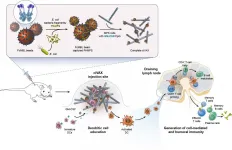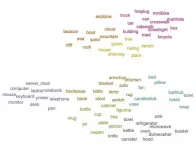(Press-News.org) For the first time, Princess Margaret researchers have mapped out where and how leukemia begins and develops in infants with Down syndrome in preclinical models, paving the way to potentially prevent this cancer in the future.
Children with Down syndrome have a 150-fold increased risk of developing myeloid leukemia within the first five years of their life. Yet the mechanism by which the extra copy of chromosome 21 predisposes to leukemia remains unclear.
Down syndrome is a genetic disorder caused by a random error in cell division in early human development that results in an extra copy of chromosome 21. This extra copy is what causes the developmental changes and physical traits associated with the syndrome, including the predisposition to leukemia.
However, the exact blood cell type in which leukemia begins in fetal development, along with the genetic alterations that cause this cell to become preleukemic, has eluded researchers until now. Furthermore, the additional mutations that must accumulate during childhood to transform preleukemia into acute leukemia were unknown.
The study and results of the early evolution of leukemia in Down syndrome from the laboratory of Princess Margaret Senior Scientist Dr. John Dick are published in Science, July 9, 2021. Post-doctoral fellow Dr. Elvin Wagenblast is first author, and Affiliate Scientist Dr. Eric Lechman is co-senior author, along with Dr. Dick.
"A whole sequence of cellular events have already happened before a person is diagnosed with the disease," explains Dr. Dick. "You can't tell at that point which sequence of events happened first, you just know that it has already happened.
"For the first time, our model is giving us insight into the human leukemia process. Ultimately, we may be able to prevent the acute illness by treating it in its earliest phase, when it is preleukemic, to prevent its progression to full blown leukemia."
Using a preclinical model that includes human Down syndrome cells from a human tissue biobank, along with an enhanced CRISPR/Cas9 method for gene alteration in human blood stem cells that was developed by Drs. Wagenblast and Lechman at Princess Margaret, the team set out to chart the steps involved in this specific leukemia evolution.
Transient preleukemia is a unique condition frequently occurring in newborns with Down syndrome, which can either spontaneously disappear within days to months of birth, or transform into acute myeloid leukemia within four years by acquiring additional mutations in some individuals.
What Drs. Wagenblast, Lechman and Dick revealed in this work was the distinct cellular and genetic events related to transient preleukemia, from their beginnings in the fetus, to further progression to leukemia in childhood.
Specifically, the team was able to test a variety of blood cell types and pinpoint that transient preleukemia originates only from long-term hematopoietic stem cells (HSCs), with the GATA1 mutation, as early as the second trimester of a fetus with Down syndrome. Preleukemia does not begin in HSCs from non-Down syndrome samples.
Only HSCs are able to regenerate the entire blood system and maintain long-term output due to their unique continuous capacity for self-renewal. In a broader picture, the fact that the cellular origin of pediatric leukemia is limited to only long-term HSCs might have implications for other kinds of childhood leukemias beyond Down syndrome.
Acute leukemia happens only after the first two mutations - the extra copy of chromosome 21 and the GATA1 mutation - are in place and have "primed" the progeny or descendants downstream of the altered long-term HSCs to acquire further mutations that lead to fully transformed acute leukemia, explains Dr. Lechman.
"We actually created a human disease in a preclinical model by showing how the genetically edited, as well as the normal human blood stem cells, behave in it, and we succeeded in recreating the precise, progressive steps of how leukemia develops," says Dr. Dick. "We now have a lot of clues as to the genetic abnormalities these mutations are driving when they cause leukemia."
The team also identified CD117/KIT as a unique protein cell surface marker on the altered disease-driving stem cells that causes the cells to proliferate. In the preclinical model and setting, the researchers were able to target and eliminate preleukemic stem cells using small molecule CD117/KIT inhibitors to prevent their progression to acute leukemia.
The researchers note that this preventative strategy could potentially be used in Down syndrome newborns and even expanded to other childhood leukemias that are known to be initiated during fetal development.
"The clinical significance of being able to target pre-cancerous lesions and preventing progression to cancer is profound," says Dr. Dick, "It would transform the pediatric cancer field."
INFORMATION:
The work was supported by the Human Frontier Science Program, Alex's Lemonade Stand Foundation, The Leukemia & Lymphoma Society and The Leukemia & Lymphoma Society of Canada, Portuguese Foundation for Science and Technology, Princess Margaret Cancer Centre Foundation, Ontario Institute for Cancer Research, Canadian Institutes for Health Research, International Development Research Centre, Canadian Cancer Society, Terry Fox Research Institute Program Project Grant, University of Toronto's Medicine by Design.
Competing Interests
Daniel D De Carvalho: Pfizer and Nektar Therapeutics research funding; DNAMx Inc: co-founder and shareholder. John E. Dick: Celgene research funding; former member of Trillium Therapeutics advisory board. All other authors declare no competing interests.
About Princess Margaret Cancer Centre
Princess Margaret Cancer Centre has achieved an international reputation as a global leader in the fight against cancer and delivering personalized cancer medicine. The Princess Margaret, one of the top five international cancer research centres, is a member of the University Health Network, which also includes Toronto General Hospital, Toronto Western Hospital, Toronto Rehabilitation Institute and the Michener Institute for Education at UHN. All are research hospitals affiliated with the University of Toronto. For more information: http://www.theprincessmargaret.ca
Proactive, frequent rapid testing of all students for COVID-19 is more effective at preventing large transmission clusters in schools than measures that are only initiated when someone develops symptoms and then tests positive, Simon Fraser University researchers have found. Professors Caroline Colijn and Paul Tupper used a mathematical model to simulate COVID-19's spread in the classroom and published their research results today in the journal PLOS Computational Biology.
The simulations showed that, in a classroom with 25 students, anywhere from zero to 20 students might be infected after exposure, depending on even small adjustments ...
(BOSTON) -- Current clinical interventions for infectious diseases are facing increasing challenges due to the ever-rising number of drug-resistant microbial infections, epidemic outbreaks of pathogenic bacteria, and the continued possibility of new biothreats that might emerge in the future. Effective vaccines could act as a bulwark to prevent many bacterial infections and some of their most severe consequences, including sepsis. According to the END ...
Feeling anxious about health, family or money is normal for most people--especially during the COVID-19 pandemic. But for those with anxiety disorders, these everyday worries tend to heighten even when there is little or no reason to be concerned.
Researchers from Indiana University School of Medicine recently studied the behaviors associated with anxiety--published in Psychopharmacology--examining how biological factors impact anxiety disorders, specifically in females. They found that anxiety in females intensifies when there's a specific, life-relevant condition.
The team, led by Thatiane De Oliveira Sergio, PhD, postdoctoral fellow in the laboratory of Woody Hopf, PhD, professor of ...
Lesbian, gay, and bisexual Veterans from the Vietnam era report PTSD and poorer mental health more often than their heterosexual counterparts, according to an analysis of data from the Vietnam Era Health Retrospective Observational Study (VE-HEROeS).
A greater burden of potentially traumatic events among LGB Veterans, such as childhood physical abuse, adult physical assault, and sexual assault, was associated with the differences.
"This study is the first to document sexual orientation differences in trauma experiences, probable PTSD, and health-related quality of life in LGB Veterans using a nationally representative sample," said Dr. John Blosnich, ...
ITHACA, N.Y. - Placing rodent traps and bait stations based on rat and mouse behavior could protect the food supply more effectively than the current standard of placing them set distances apart, according to new research from Cornell University.
Rodents cause billions of dollars in losses to the food supply each year, and carry pathogens that can sicken and kill humans, including salmonella, E. coli and Leptospira.
In the 1940s and 50s, scientists recommended that farmers, food manufacturers and distributors evenly space rodent traps or bait boxes in their facilities. But in fact, a new study finds placement based on rat and mouse behavior is more effective.
"From there, it just became a mantra without anybody scientifically evaluating it to see whether this ...
The new study, titled "Liposomal Extravasation and Accumulation in Tumors as Studied by Fluorescence Microscopy and Imaging Depend on the Fluorescent Label," was published on July 1, 2021, in the prestigious journal of the American Chemical Society, ACS Nano.
Liposomes, a type of nanoparticle, are tiny, fat-soluble vesicles (small, fluid-filled sacs) made from lipids, or fats. They are mainly used to deliver cancer-fighting drugs to tumors, since liposomes are not water soluble and can protect some drugs against breaking down in the body.
Comparing fluorescent labels on liposomes ...
The recent extreme heat in the Western United States and Canada may seem remarkable now, but events like these are made more likely, and more severe, under climate change. The consequences are likely to be far-reaching, with overwhelmingly negative impacts on land and ocean ecosystems, biodiversity, food production and the built environment.
"The main lever we have to slow global warming is the rate at which CO2 is added to the atmosphere," said Marcus Thomson, a postdoctoral scholar at the National Center for Ecological Analysis & Synthesis at UC Santa Barbara. Thomson is a co-author of a research article just published in Nature ...
When people see a toothbrush, a car, a tree -- any individual object -- their brain automatically associates it with other things it naturally occurs with, allowing humans to build context for their surroundings and set expectations for the world.
By using machine-learning and brain imaging, researchers measured the extent of the "co-occurrence" phenomenon and identified the brain region involved. The findings appear in Nature Communications.
"When we see a refrigerator, we think we're just looking at a refrigerator, but in our mind, we're also calling up all the other things in a kitchen that we associate with a refrigerator," said corresponding author Mick Bonner, a Johns Hopkins University cognitive scientist. "This is the first time anyone has quantified this and identified ...
A team of the University of Barcelona has analysed for the first time what the dry and hot periods could be like in the area of the Pyrenees depending on different greenhouse emission scenarios. The results, published in the journal Natural Hazards and Earth System Sciences, show that under an intermediate scenario, where these emissions that accelerate the climate change could be limited, there would not be a rise in long-lasting dry episodes, but temperatures would rise during these periods. On the other hand, if those emissions were not reduced during the 21st century, the summer no-rain periods would last an average ...
In a new study assessing the potential of a single-dose, intranasal COVID-19 vaccine, a team from the University of Iowa and the University of Georgia found that the vaccine fully protects mice against lethal COVID-19 infection. The vaccine also blocks animal-to-animal transmission of the virus. The findings were published July 2 in the journal Science Advances.
"The currently available vaccines against COVID-19 are very successful, but the majority of the world's population is still unvaccinated and there is a critical need for more vaccines that are easy to use and effective at stopping disease and transmission," says Paul McCray, MD, professor of pediatrics-pulmonary medicine, and microbiology and immunology ...





